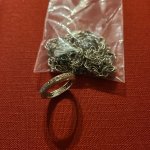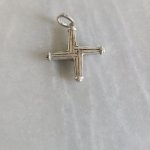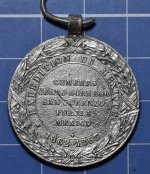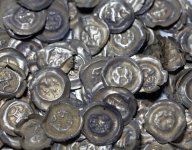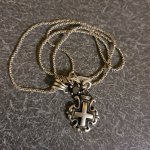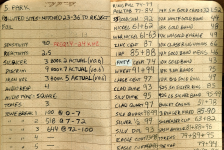Here's my story and I'm sticking to it...
I have the Deus-2 for a year now, moving up from the Deus-1. I had been doing mostly a farm fields and occasionally a rural park until this past week. I decided to go to a sports field and hunt for jewelry. So I modified the park program for shallow targets and ran with it.
I ignored the signals that were in the range of zinc penny 82-85. I was digging enough pull tabs and pieces of foil to fill my pouch so I didn't need the added frustration of zinc pennies.
I came across target that sounded like a coin spill. Target responses were 85-94 so I knew I probably had a quarter and zinc penny. What I dug was a coin ring made from a quarter next to a .925 medium sized silver chain (pictured in the bag because it's broken).
I didn't think much of it and continued on. Over the next couple hours, I dug what I thought was a small costume jewelry ring. When I got home and cleaned it up, the ring turned out to be a diamond wedding band in 18k white gold (pictured with the chain).
I returned the next day to look for the possibility of a matching engagement ring. At that time I decided to dig every shallow target including the zinc pennies. Long story short, I was digging a zinc penny signal but pulled a .925 solid silver pendant out of the hole (pictured).
Now I'm seeing a pattern. All other targets were on the money TID wise. Copper pennies 90, clad dimes 90 and quarters 94, nickels 62, etc. But in my experience (~10 years) using the D1 on 18khz, all TID being equal, the .925 should ring up with a TID over 90.
I won't be ignoring zinc penny signals from now on. Anybody else have that experience with .925 silver using the D2?
I have the Deus-2 for a year now, moving up from the Deus-1. I had been doing mostly a farm fields and occasionally a rural park until this past week. I decided to go to a sports field and hunt for jewelry. So I modified the park program for shallow targets and ran with it.
I ignored the signals that were in the range of zinc penny 82-85. I was digging enough pull tabs and pieces of foil to fill my pouch so I didn't need the added frustration of zinc pennies.
I came across target that sounded like a coin spill. Target responses were 85-94 so I knew I probably had a quarter and zinc penny. What I dug was a coin ring made from a quarter next to a .925 medium sized silver chain (pictured in the bag because it's broken).
I didn't think much of it and continued on. Over the next couple hours, I dug what I thought was a small costume jewelry ring. When I got home and cleaned it up, the ring turned out to be a diamond wedding band in 18k white gold (pictured with the chain).
I returned the next day to look for the possibility of a matching engagement ring. At that time I decided to dig every shallow target including the zinc pennies. Long story short, I was digging a zinc penny signal but pulled a .925 solid silver pendant out of the hole (pictured).
Now I'm seeing a pattern. All other targets were on the money TID wise. Copper pennies 90, clad dimes 90 and quarters 94, nickels 62, etc. But in my experience (~10 years) using the D1 on 18khz, all TID being equal, the .925 should ring up with a TID over 90.
I won't be ignoring zinc penny signals from now on. Anybody else have that experience with .925 silver using the D2?



